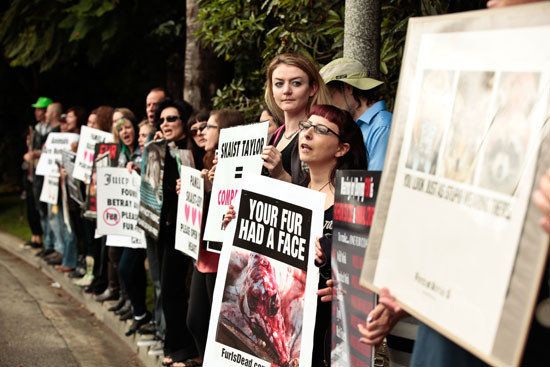
This story comes courtesy of Dog Park Media.
Juicy Couture, the brand that built a fashion empire out of rhinestone-studded velour track suits with “Juicy” emblazoned across the ass, became a darling of animal lovers in 2008 when it pledged to go fur-free.
But on Saturday, Juicy Couture co-founder Pamela Skaist-Levy found the street outside her Beverly Hills home the site of a demonstration by dozens of animal rights protesters shaming her and her business partner Gela Nash-Taylor for trading in the pelts of foxes, raccoons and other animals that were raised in confinement and brutally killed for fashion industry profits.
Juicy Couture is still listed on the Humane Society’s website as a fur-free designer. But now Skaist-Levy and Nash-Taylor, who left the company two years ago, have a new fashion line out called Skaist Taylor which embraces fur with the same ostentatious aplomb with which Juicy showcases costume jewelry and the color pink.
The fur trade has been the object of protests and boycotts for decades for its horrific treatment of animals.
“Animals including fox, rabbits, mink, cheetah, and even dogs and cats are gassed, beaten, have their necks broken, are caught in steel-jaw leg hold traps and vaginally and anally electrocuted for their fur,” said animal rights attorney Shannon Keith, who produced a documentary on the fur industry called "Skin Trade" and was one of the campaigners behind West Hollywood’s ban on fur retail a year ago. “If someone were caught anally electrocuting a dog, they would be arrested and sent to prison for felony animal cruelty; however, because the fur industry is completely unregulated, those who control it get away with it.”
The demonstration today was organized by two longtime anti-fur activists, Ellen Lavinthal and Jessica Schlueter. Lavinthal was one of the primary organizers behind the West Hollywood fur ban, and Schlueter helped launch a boycott of a major fur retailer.
At one time, Lavinthal, who lives in the neighborhood, was friends with Skaist-Levy. That relationship had already grown distant, but ultimately soured over Skaist-Levy’s decision to use fur as a centerpiece in her new Skaist Taylor line.
Story continues below.
“I approached Pamela when she appeared on the front page of the L.A. Times wearing fur to promote her new line,” said Lavinthal. “The next day, my daughter and I reached out to her and dropped off a letter from my daughter asking her to stop using fur, as well as a copy of "Skin Trade" and some literature about the fur industry. I told her that I and the rest of the animal rights community would be glad to help promote her new line if she changed her mind about fur. A few weeks later, we gave her a petition with 33,000 names on it. When she didn’t do anything about it, we were left with no choice but to protest.”
Skaist Taylor’s press agent did not respond to repeated attempts to contact the company for comment.
Schlueter also had a falling out — not with the designer herself, but with the Juicy Couture brand. Like countless other young women around the world in high school and college, Schlueter spent “hundreds, if not thousands of dollars” on Juicy clothes. The company’s image appealed to her: the story of two women with practically no resources starting a global brand out of their small L.A. apartment was irresistible. Juicy Couture’s pledge to go fur-free sealed her brand loyalty.
Now, Schlueter feels disappointed and betrayed, dismayed that all the money she spent on Juicy Couture clothes over the years had only helped further the careers of two fashion industry giants who then went on to become part of the multibillion dollar fur industry.
“I don’t think they are horrible people, I think they have spent years in a community that glamorizes fur and that mocks people who stand up against its inherent cruelty,” Schlueter explained.
Skaist Taylor has no physical stores, so the activists chose Skaist-Levy’s home residence as the site for their demonstration. Especially given its residential setting, the protest was conceived from the start as a calm, peaceful, educational action -- no screaming in people’s faces or mixing it up with the cops.
But demonstrations in front of private homes are an inherently risky tactic for animal rights activists. Federal prosecutors have shown a willingness to classify “home demos” as acts of terrorism under the 2006 Animal Enterprise Terrorism Act, a law that the fur trade and other animal-based industries lobbied for and which was written explicitly to criminalize certain protest tactics in animal rights campaigns that are Constitutionally protected in every other context. In 2009, the government indicted four Santa Cruz animal rights activists on terrorism charges for engaging in First Amendment activities, including protests in front of the homes of UC Santa Cruz vivisectors, claiming a connection between those actions and two 2008 firebombings of the car and the home of two UCSC scientists, crimes which remain unsolved. A federal judge threw out the indictments the following year for lack of specificity.
With about one bike cop for every three protesters, however, no tension was visible between law enforcement and activists at the demonstration today. Protesters restrained their passion with civility, aiming to reach the public instead of alienating it. A few Star Tours vans passing by slowed down for tourists to take pictures.
The organizers were pleased. “I’m beyond thrilled that this was one of the largest home demos ever in the United States,” said Leventhal. “The fact that so many people would give up their Saturdays and choose to be there really made a statement of how strongly they feel about the use of fur in fashion.”
Leighton Woodhouse is a founding partner, film producer and graphic designer at Dog Park Media. To read more Dog Park Media stories, click here.
